Among thousands of open-source platforms available for eCommerce merchants, ZenCart vs Magento definitely steals the spotlight as the top contenders. Each platform brings unique benefits and offerings to the table, leaving many merchants wondering which one is the better match for their business.
No worries; we're here to make your decision easier. In this article, we'll explore their differences in terms of:
- Pricing
- Ease of use
- Hosting, Performance & System requirements
- Customization
- eCommerce features
- Extensions
- SEO & Marketing features
- Integration capabilities
- Security
- Customer support
We'll also share our take on which type of business is best suited for each platform. Without further ado, let’s get started!
About ZenCart vs Magento
Before exploring the features in detail, here's a quick overview of what ZenCart vs Magento promises to offer:
ZenCart: A budget-friendly, customizable solution
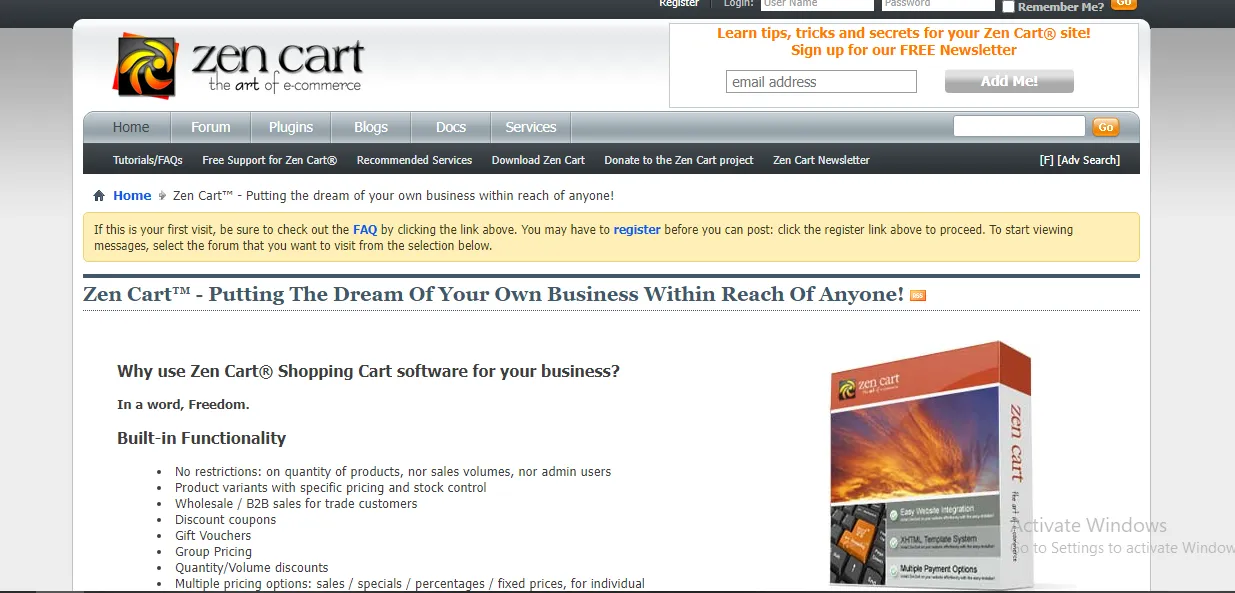
Launched in 2003, ZenCart is an open-source platform designed to help users build and manage their own online stores. Its open-source foundation means you can easily adjust the store's look and feel—as well as the functionality—to match your unique vision.
As of February 2025, around 28,000 store owners (mainly in the US and UK) use Zen Cart, though its popularity has declined due to emerging competition and a lack of modernized features.
ZenCart Pros | ZenCart Cons |
+ Completely free to download and install + Highly customizable with access to source code + Manageable ongoing expenses; works well with shared hosting + Simple and organized interface once set up + A large library of extensions available, most of them free + Compliant with PCI standards | - Manual installation required (no support for third-party tools) - Limited built-in SEO and marketing tools - Security patches are infrequent - Lacks direct customer support (relies on community forums) |
Magento: A scalable, feature-rich solution

Since its 2008 release, Magento has quickly become a leading eCommerce platform, serving as the driving force behind over 110,000 active online stores (mostly in the US, UK, and Netherlands) today. As of our writing, it offers two distinct versions to cater to a wide range of business needs:
- Magento Open Source (Free – Our main focus): Magento 2 offers complete control over every aspect of the store's design and functionality. However, the trade-off is that it demands a certain level of technical/coding expertise.
- Adobe Commerce Cloud (Paid versions): Adobe Commerce Cloud provides a more polished, pre-configured platform than Magento 2, thanks to the built-in support and a set of ready-to-go features. It's ideal for companies prioritizing convenience and all-inclusive solutions over customization.
Magento Pros | Magento Cons |
+ Free to download and install + Highly customizable + Fast loading speed + Over 4,000 extensions + Built-in SEO tools and marketing features + Frequent security updates + Strong community support with extensive documentation + Multi-store management under one domain | - Steep learning curve for installation - Only 2 built-in payment gateways (PayPal and Braintree) |
Why does Magento have the competitive edge?
As you can see, both Zen Cart and Magento provide open-source, PHP-based solutions that give store owners full control over their eCommerce sites. However, Magento’s modern features, scalability, and stronger community support have made it the preferred choice for many merchants.
Continue reading to explore the details that distinguish these two platforms and determine which one is best for your business!
Seamlessly migrate your store to Magento!

ZenCart vs Magento Pricing: Zen Cart is More Affordable
Keeping business within budget must always be among the top priorities, especially for small stores and start-ups looking to grow. That's why we've made it our mission to analyze the pricing of Magento vs ZenCart:
ZenCart pricing
As we’ve highlighted, ZenCart’s open-source nature means it’s completely free to download and install. But once the setup is complete, there will be a range of ongoing costs:
Feature or Service | Expenses (Average) |
Hosting | $2 to $35/month |
Theme | $0 to $50 (one-time) |
Extensions | $0 to $25/month |
SEO | $50/month |
Maintenance | $200/month |
Security | $200/year |
Depending on the chosen services and features, you might expect annual expenses ranging from $824 to $3,920.
Magento pricing
Just like ZenCart, Magento Open Source is free to download and install (no surprise, given the “Open Source” in its name). But the zero-cost software aside, running a Magento store still comes with its own set of expenses that you'll need to factor in:
Feature or Service | Expenses (Average) |
Hosting | $50/month |
Theme | $200 (one-time) |
Extensions | $150/month |
SEO | $50/month |
Maintenance | $180/month |
Security | $225/year |
All things considered, the yearly expense of running a Magento store can soar to roughly $5,585.
The Verdict
Both ZenCart and Magento are free to install. Nevertheless, with significantly lower ongoing expenses, ZenCart comes out as the winner in this battle between ZenCart and Magento.
Ease of Use: It's A Tie
Another key factor you can't overlook is the platform's ease of use. Imagine wasting weeks just trying to get the hang of it—your entire business schedule would fall apart! With that in mind, let's see how ZenCart vs Magento measures up here.
ZenCart ease of use
Based on our research, ZenCart's installation process can be simplified by reputable third-party apps like Softaculous or Installatron. Yet, for undisclosed reasons, ZenCart specifically advises users against using these tools in its official documentation. As a result, you are left with only one path – manual installation, which can be quite a challenge for those unfamiliar with command lines or server setups.
But here’s the great news: ZenCart redeems itself with a remarkably simple and organized interface once the initial setup is complete!
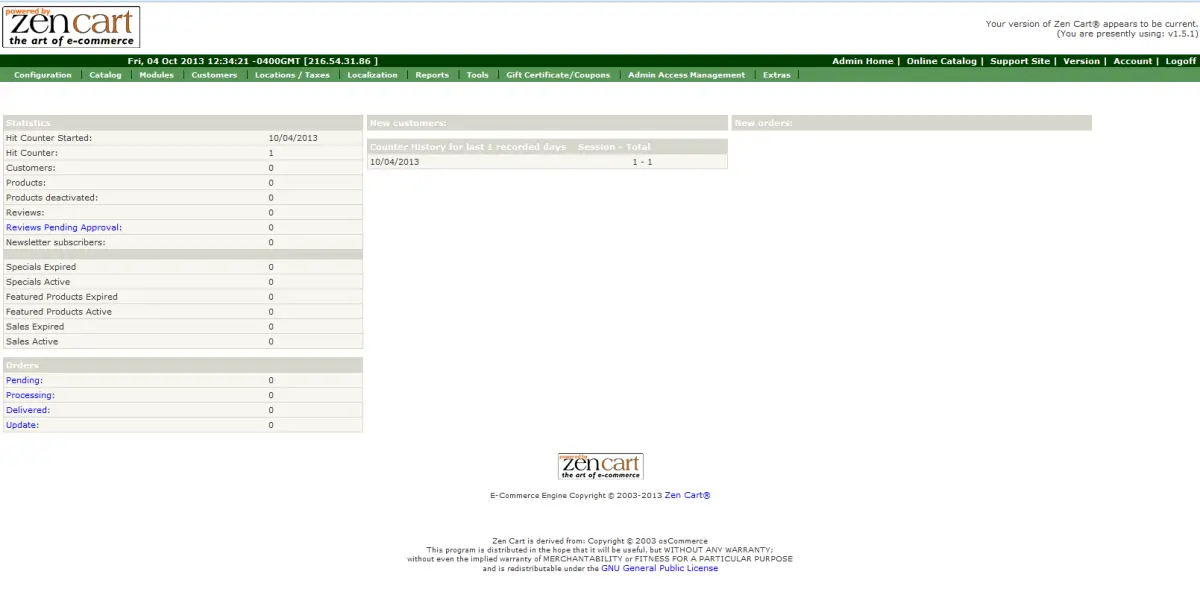
Its layout is fairly intuitive, with a tab bar at the top of the dashboard that features clear dropdown menus. Plus, each menu displays all the category's important attributes in one go, meaning users can see everything at once without juggling through multiple screens. You only need a few quick clicks to access and modify the settings.
Magento ease of use
All in all, installing Magento can be fairly manageable, but it does come with a learning curve. You'll need to configure the web server, followed by an 11-step procedure to set up the import files (which we break down in our Magento tutorial). Not to mention, you might hit a few technical snags along the way that need extensive troubleshooting!
Fortunately, the real payoff comes once you're in: Magento's dashboard is a dream to navigate. All important categories and groups are neatly tucked into the left-hand menu, allowing you to glide through each section and tweak the settings with ease.

The Verdict
Both ZenCart vs Magento offer intuitive interfaces, though their installation processes still take time and effort. It's too close to pick a clear winner, so we're calling this round a deadlock.
Hosting, Performance & System Requirements: Magento Offers Better Performance
Needless to say, a slow-loading page with frequent downtime is obviously a traffic killer! That's why hosting and performance are considered the decisive factors between a website's success or failure. And after thorough hands-on testing, we have finally uncovered some eye-opening insights into how ZenCart vs Magento performs in this area:
ZenCart hosting and performance
Designed for simplicity, Zen Cart runs efficiently on a traditional LAMP stack (Linux, Apache, MySQL, PHP). It supports PHP 7.3 or higher and MySQL 5.7+, making it compatible with most budget-friendly shared hosting services. This makes Zen Cart a cost-effective choice for small businesses with limited traffic and simple product catalogs.
As an open-source platform, ZenCart requires you to choose your own hosting provider. The great news is that it's compatible with many top industry hosts, such as Bluehost and Hostinger.
And if you're looking to cut costs without sacrificing performance, ZenCart itself recommends AEIIA, Digital Ocean, and NodePing, all coming way under $50 per month. All our trial ZenCart websites have performed quite smoothly with all these providers without any significant issues!
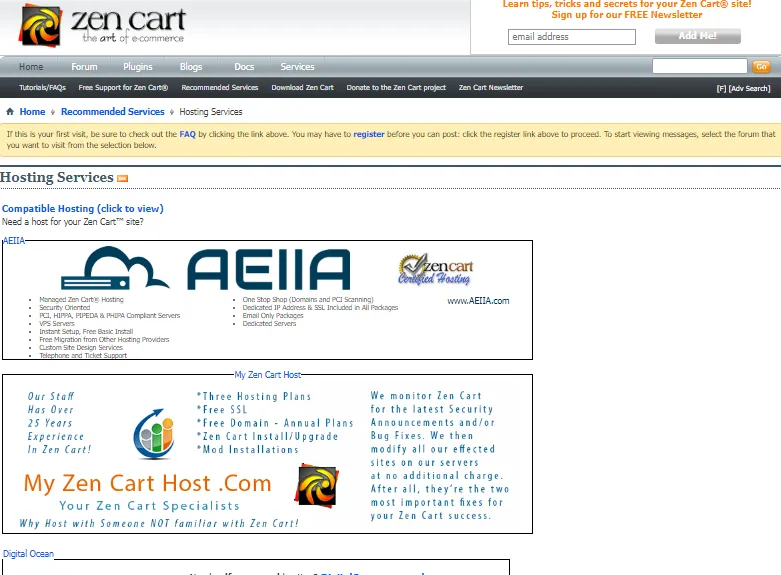
Regarding speed, ZenCart holds its own but doesn't deliver exactly spectacular results. Our tests revealed ZenCart sites took 1-3 seconds to load, which is a bit of a gamble compared to Google's gold standard of under 2 seconds.
Magento hosting and performance
Built for scalability, Magento requires a more powerful hosting setup. It supports both LAMP and LEMP stacks (Linux, Apache/Nginx, MySQL/MariaDB, PHP) and needs PHP 7.4+ and MySQL 5.7+/MariaDB 10.4+. For optimal performance, Magento benefits from advanced caching technologies like Varnish and Redis, as well as high-performance SSD hosting.
Like ZenCart, Magento requires you to choose your own hosting provider, though that isn't exactly a disadvantage since reliable options are easy to find. Hostinger, Cloudways, and Bluehost, for example, are all recognized for their strong uptime and security!
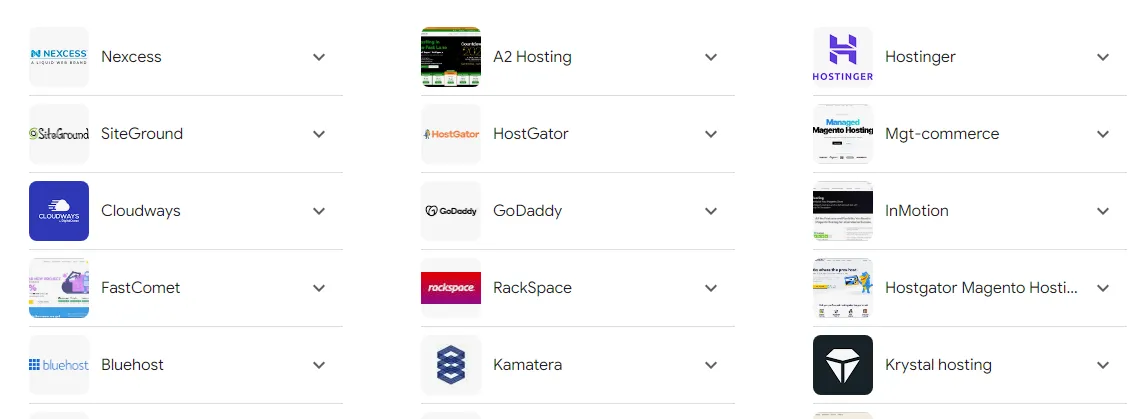
Speed is another area where Magento truly excels: in our tests, it only needed about 0.6 seconds (sometimes less) of loading time. This number far exceeds Google's recommended speed and also puts Magento ahead of ZenCart.
The Verdict
Finding a dependable hosting provider for both ZenCart vs Magento is simple, even for beginners. But when it comes to performance, Magento's lightning-fast loading speed easily makes it the champion in this round.
Customization: It's A Tie
As website-building becomes increasingly commonplace, the big question is: how much can you make the site uniquely yours and set it apart from others? No worries; we have made sure to include customization in our Magento 2 vs ZenCart comparison:
ZenCart customization
Zen Cart offers a variety of themes developed by third-party designers, though the exact number of available themes may vary depending on the source. Many themes are scattered across different marketplaces, such as TemplateMonster, and include both free and premium options.
You can make some simple adjustments for them using the existing settings, such as:
- Changing the width of side boxes
- Removing the search box from the header
- Modifying how categories, checkout buttons, and product statuses are displayed.

However, any customization requirements other than these require you to add your own custom codes or overrides. Even something as simple as changing colors and fonts involves additional stylesheets manually edited in text editors! While this gives users incredible control over their sites' design, those without coding experience will likely find it quite daunting.
Magento customization
Like ZenCart and basically all other open-source platforms, Magento lets you shape every aspect of your store's look and feel.
But with great power comes (a lot of) complexity! Sure, you can change the theme's default color using built-in settings, but anything else requires custom coding and style sheets. And with only 11 official themes to choose from, the limited pre-set options will likely make things even more daunting for beginners.
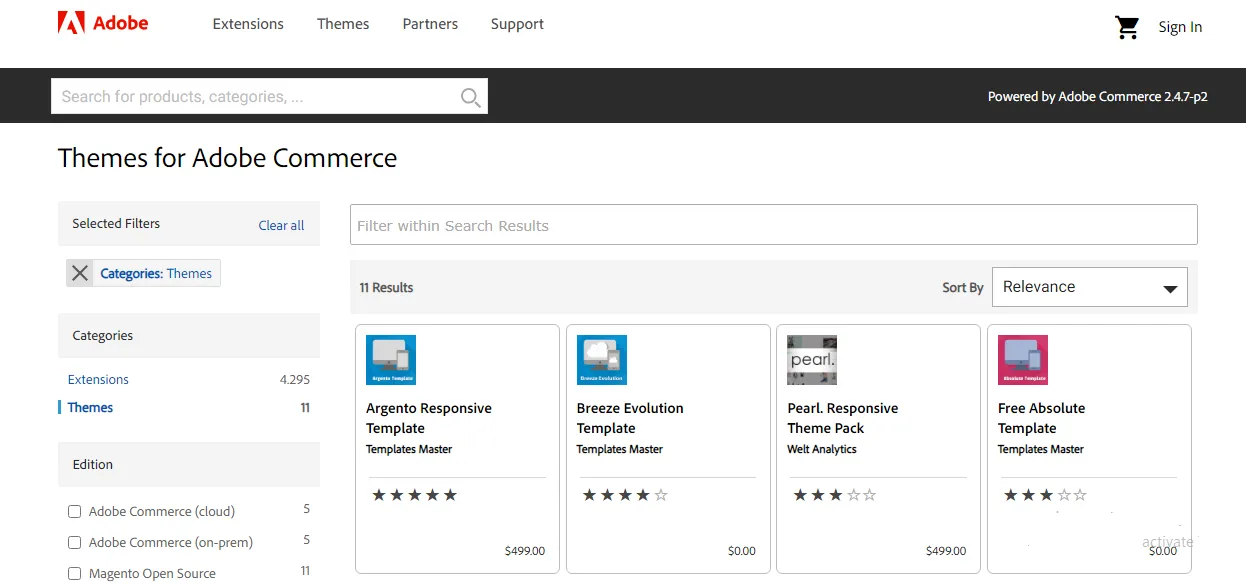
On another note, if you're willing to explore themes outside Magento's official collection, you'll find plenty that come with a handy Theme Editor (meaning no coding is required). To avoid technical hiccups, make sure to do research and confirm that the theme you pick works smoothly with your current Magento edition.
The Verdict
There are thousands of Magento themes tailored for non-tech-savvy users, but claiming those unofficial themes as an “advantage” over ZenCart feels quite misleading. Hence, we still declare this round a tie, as both OpenCart vs Magento deliver a similarly high level of customization for advanced users.
eCommerce Features: Magento is More Comprehensive
At the end of the day, the success of an eCommerce store hinges on its eCommerce features! That's why we're now jumping into a head-to-head ZenCart vs Magento comparison in terms of inventory management, payment solutions, shipping settings, and multi-vendor functionality:
Inventory management
Like other store features, ZenCart aims to give users the freedom to customize their inventory management.
But in case you're not ready to go there yet, the built-in stock management tools are thankfully more than enough to have you covered! Simply head to “Admin” > “Configuration” > “Stock,” then use the available configuration settings to keep your inventory running smoothly:
Key | Description |
STOCK_CHECK | Verify if there is enough stock available. |
STOCK_LIMITED | Decrease the stock count based on product orders. |
STOCK_ALLOW_CHECKOUT | Permit customers to complete checkout even with insufficient stock. |
STOCK_MARK_PRODUCT_OUT_OF_STOCK | Indicate visually which products are out of stock for customers. |
STOCK_REORDER_LEVEL | Set the threshold for when stock should be replenished. |
SHOW_PRODUCTS_SOLD_OUT | Control product visibility when out of stock: |
DISABLED_PRODUCTS_TRIGGER_HTTP200 | Determine how search engines treat disabled products: |
SHOW_PRODUCTS_SOLD_OUT_IMAGE | Replace the Add to Cart button with a Sold Out image. |
ENABLE_DISABLED_UPCOMING_PRODUCT | Specify how disabled products with a future availability date are activated when the date arrives. |
QUANTITY_DECIMALS | Allow specification of decimal places for quantity. (0 = off). |
Similarly, we are very impressed by Magento's powerful inventory management capabilities. Of course, you still have the option to fully customize the backend, but the default settings alone are more than enough to establish an efficient stock management system:
Setting | Description |
'Decrease Stock When Order is Placed' | Reduces the stock quantity when a customer places an order. |
'Set Items' Status to be in Stock When Order is Canceled' | Returns items from canceled orders back to stock automatically. |
'Display Out-of-Stock Products' | Option to display or hide products that are currently out of stock on the store's website. |
'Only X Left Threshold' | Sets a notification limit to alert customers when there is a low stock quantity. |
'Manage Stock' | Turns on or off stock management for each specific product. |
'Backorders' | Allows customers to place orders for products that are currently out of stock. |
'Maximum Qty Allowed in Shopping Cart' | Configure the maximum number of units that a customer can add to their shopping cart. |
'Out-of-Stock Threshold' | Sets the threshold value to display when a product is out of stock. |
'Minimum Qty Allowed in Shopping Cart' | Sets the minimum number of items required for a customer to place an order. |
'Customer Groups' | Allows setting minimum quantity rules for different customer groups. |
'Automatically Return Credit Memo Item to Stock' | Automatically returns refunded products to stock after processing a credit memo. |
Payment
For built-in offline methods, ZenCart offers two options as of our writing:
- Check/Money Order: This option puts the responsibility on the buyers; they have to send you their payments first. You can set the order status to “Pending” and keep it that way until the check or money order arrives.
- Cash on Delivery (COD): Unlike Check/Money Order, choosing COD means customers only pay when they receive their order upon physical deliveries. Hence, it is ideal for businesses dealing with local customers.
How about online gateways? You will have to install ZenCart's payment modules. There are about 200+ options available, covering many popular gateways like PayPal, Stripe, Zelle, Braintree, and more.
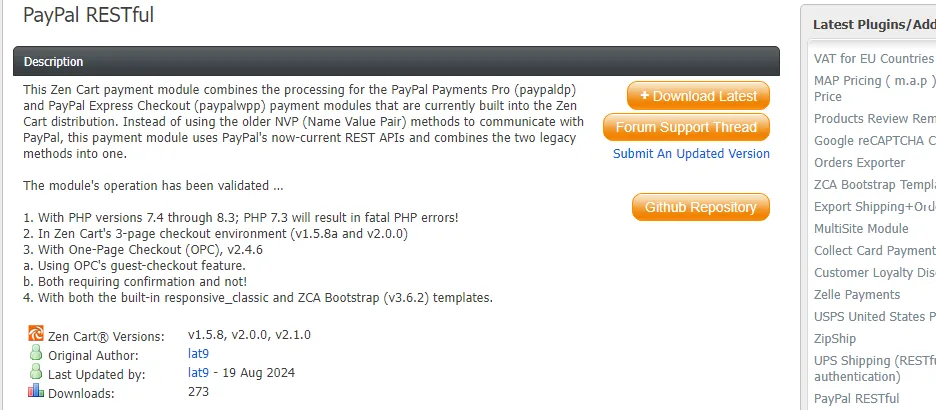
In 2025, Zen Cart received updates to the PayPal RESTful integration, improving payment processing capabilities within Zen Cart.
Meanwhile, Magento does offer some built-in payment gateways (though they aren't much – only PayPal and Braintree).
Fortunately, much like ZenCart, expanding your payment methods is a breeze thanks to Magento Connect and extra extensions. In fact, the platform boasts a staggering 607 payment-related extensions (ranging from $0 to $799) to give you endless customization possibilities! 402 out of 607 extensions are dedicated to payment integrations alone, while the rest aim to improve customers' checkout experience and fraud prevention.
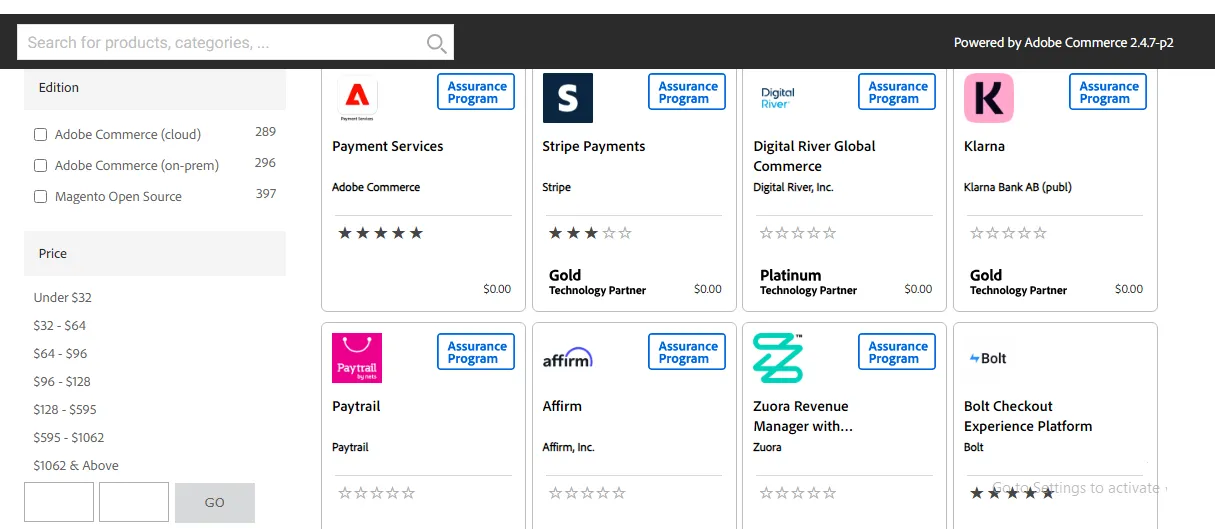
Shipping settings
With its currently available built-in options, ZenCart allows you to do the following:
- Create a shipping zone: This option lets you apply specific shipping rules to targeted regions. For example, you can create a special zone just for Hawaii and Alaska.
- Set shipping dimensions: ZenCart allows you to enter precise dimensions for the product (length, width, height, or weight) for accurate shipping calculations for every order.
- Set free shipping: Want to offer free shipping on orders over a certain amount? You can effortlessly set up conditions that trigger free shipping whenever these criteria are met.
To go beyond these basics, you need to use SQL commands to tweak the settings. Or, for an easier approach, consider choosing from ZenCart's 60+ available shipping modules; the best part is that you can program them to disable automatically when requirements aren't met. For instance, if a module is intended for U.S. orders, it will deactivate itself when handling international orders from places like the U.K. or France.
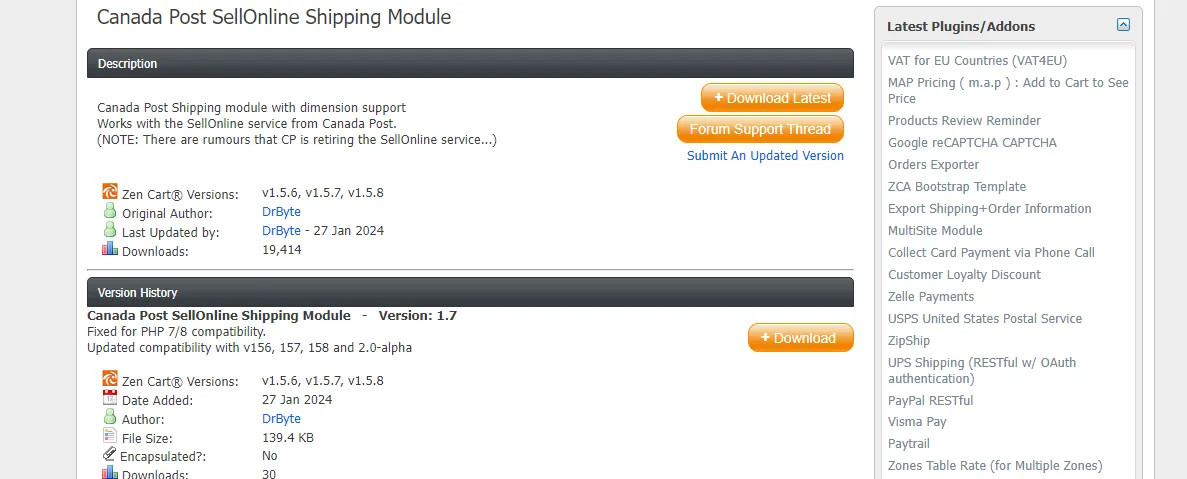
How about Magento? We are impressed that its built-in shipping settings already give users powerful control over their shipping process. With no need for extra extensions, you can already customize the following for the store's needs:
- Flat-rate shipping: This feature lets you charge a fixed shipping rate per item, whether small accessories or large products, to simplify costs.
- Shipping policy: These settings help you set clear shipping guidelines (e.g., offering free shipping for orders above a certain amount.) Since customers know what to expect upfront, you can avoid unnecessary disputes later on.
- Point of origin: Here, you can determine where orders ship from and automatically calculate tax rates based on the information to ensure accurate pricing.
- Multiple addresses: With this option, your customers can ship items to different addresses in one order (for gift-giving purposes, for example). Plus, you can set a limit on the number of addresses per order to manage logistics more efficiently.
- Free shipping: The free shipping feature can be configured to trigger whenever specific conditions are met. As a result, your customers will feel more inclined to place large orders in order to unlock free delivery.

Multi-vendor functionality
It's quite frustrating that ZenCart still lacks this feature at the time of our writing. You might be considering integrating it into your store via a module or plugin, but even that turns out to be difficult!
Some merchants have managed partial success using multi-site modules. Nevertheless, they fall short when it comes to tracking orders and monitoring the performance of individual vendors effectively.
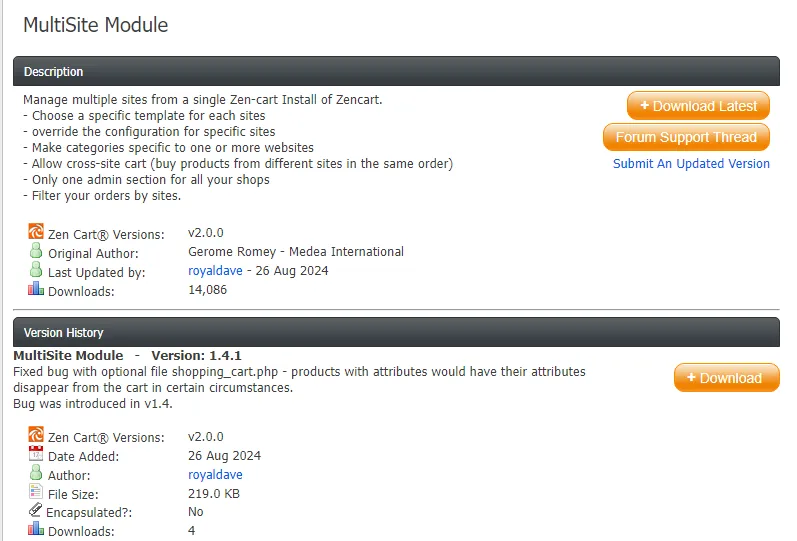
On the flip side, Magento performs much better in this regard. Although there are still no built-in multi-vendor features, Magento offers 8 extensions ($199 each on average) with customized features and dashboards for each vendor!
Even better, they come with multilingual support to let you assign each vendor/branch to a specific country or region. This feature is quite a game-changer if you're aiming for a global market.
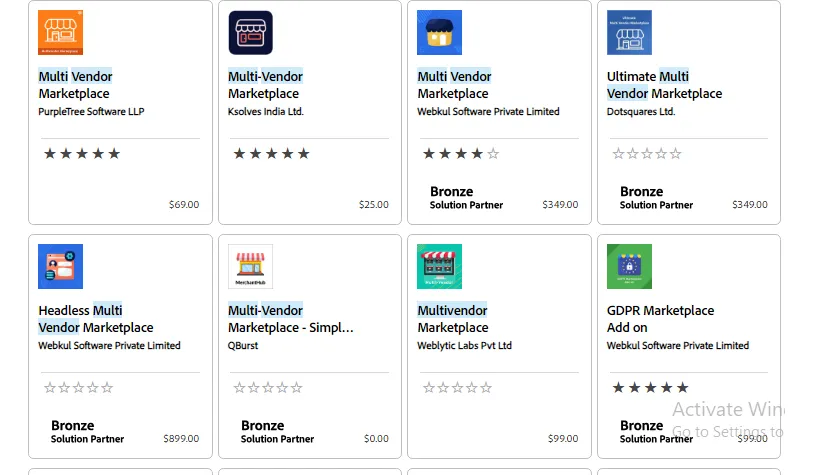
The Verdict
It's a fierce battle between ZenCart vs Magento since both platforms deliver similar performances in many areas. Nevertheless, Magento eventually took the lead with its broader range of payment options and multi-vendor capabilities.
Extensions: Magento Has More Options
In previous sections, we have given a quick nod to how ZenCart vs Magento 2 rely on extensions to cover certain gaps in their built-in features. Nevertheless, we haven’t yet explored the full range of what both platforms have to offer. Now is the time to have a closer look at their extension collections!
ZenCart extensions
As of our writing, ZenCart introduces over 2,200 extensions neatly organized into 15 main categories (with a bonus “Others” category for anything that doesn't quite fit elsewhere). The best part is that most of them are completely free, meaning you have complete control over the store's advanced settings without breaking the bank.
To make the extension hunt even easier for you, ZenCart offers the following search filters:
- Name: Allow alphabetical sorting
- Date added: Show the newest extensions added to the collection
- Total downloads: Display which extensions have been downloaded the most
- Last download: Let you track which extensions have been recently downloaded
- Author/Uploader: Track down all extensions uploaded/created by a particular developer or community
- Rating: Sort by top-rated extensions (with the highest scores and user ratings)
And it doesn't stop there. After clicking on an extension, you can access its complete update timeline – sometimes down to the specific details of each update. This helps you further confirm whether the extension is actively supported and fits your ongoing business goals.
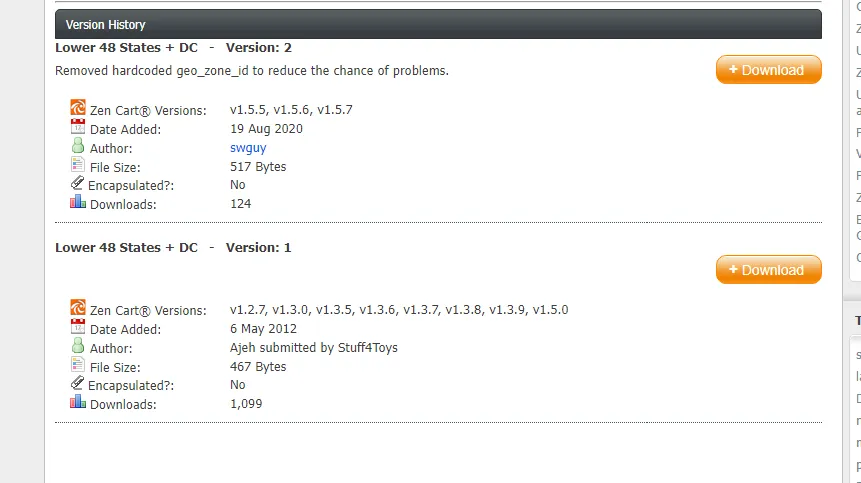
Magento extensions
We just talked about ZenCart’s extension store; how about Magento? This platform presents a huge collection of over 4,200 extensions, ranging from completely free to roughly $900 a year. Whether you're looking for free options to test the waters or premium extensions for advanced features, there's plenty to explore!
Navigating this collection is also quite a breeze, thanks to the platform's smart filtering systems. Aside from the basics (Relevance, Price, and Rating), Magento goes above and beyond with the following filters:
- Assured extensions: This label means these extensions have been thoroughly tested and verified by credible programs.
- Edition: You can quickly find the perfect fit for your current edition (either Magento Open Source or the paid editions).
- Partner type: For extra credibility, you can go for extensions developed by Adobe Gold or Platinum partners.
Plus, once you click on an extension, Magento gives you everything you need to make an informed decision. You will get full technical specs, update history, quality reports, and even a Q&A section to clear up any doubts!
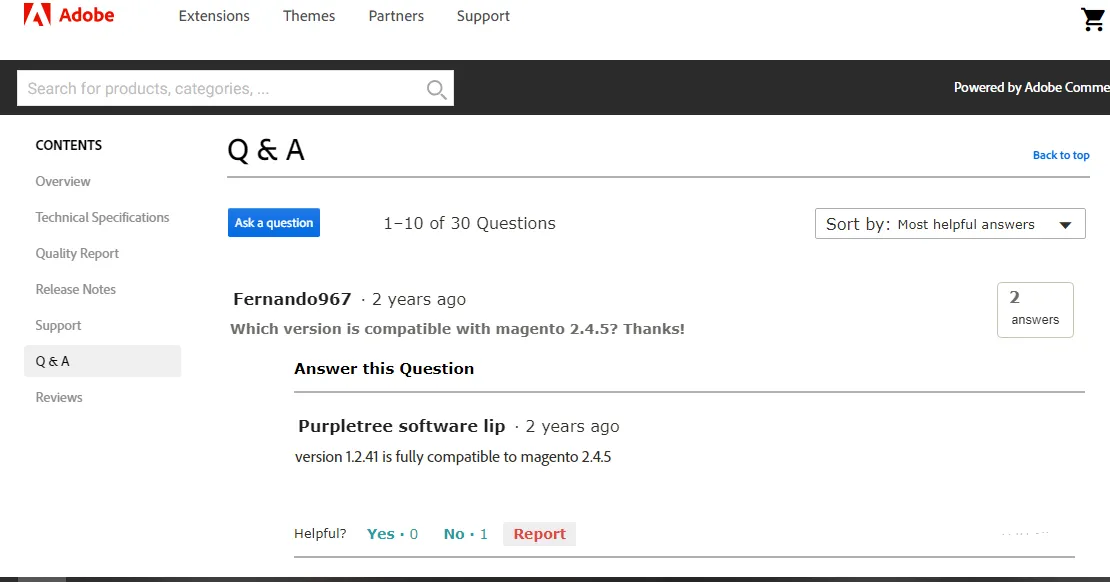
The Verdict
Both ZenCart vs Magento provide an extensive collection catering to a variety of needs. Still, Magento's library is nearly double the size of ZenCart's, and many of its extensions are rigorously tested for quality. With that in mind, we decided Magento is the winner in this round.
SEO & Marketing features: Magento Wins
With your store set up, settings fine-tuned, and the right extensions added, you're ready to take on the most critical challenge: boosting your products' visibility! ZenCart vs Magento take slightly different paths to make it happen; let's explore their approaches in this section.
ZenCart SEO & Marketing features
Regarding SEO (search engine optimization), ZenCart provides a basic SEO guide for keyword, alt text, and meta tags optimization. However, it doesn't offer any built-in tool to streamline such processes. You must use custom coding or third-party plugins to perform more advanced practices!
So far, there are around 30 free SEO-related plugins. Since there's no dedicated SEO category, you'll have to enter relevant keywords (e.g., “SEO”) into the search bar and browse the results scattered across other categories.
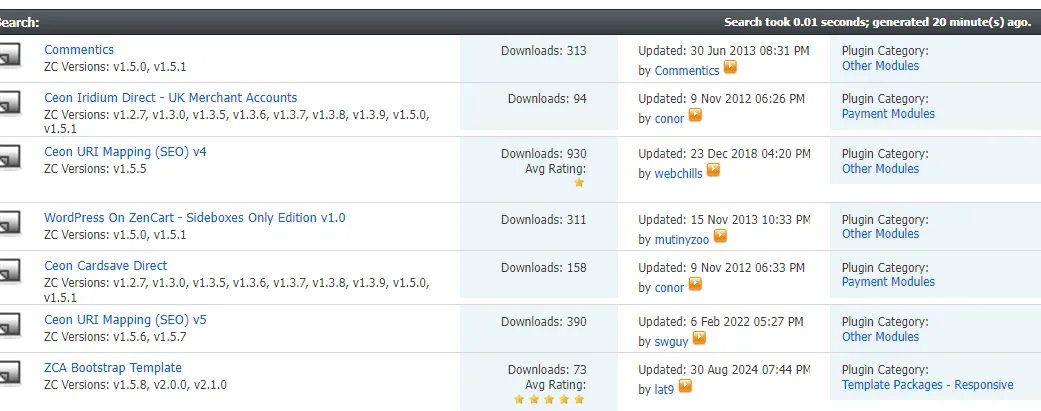
Likewise, ZenCart isn't exactly spectacular when it comes to built-in marketing tools. There is only a simple email system that allows you to:
- Bulk-send emails to multiple addresses
- Add custom messages to checkout confirmations
- Send personalized order updates
Other than that, you'll once again need to rely on plugins or custom solutions for more sophisticated marketing strategies. ZenCart currently offers 136 free plugins that provide various tools for discounts, surveys, social media integration, auto-tweets for new product releases, etc.
Magento SEO & Marketing features
For SEO beginners, Magento makes it quite easy to get started with essential tools right at your fingertips. From the dashboard, you can:
- Customize title tag prefixes and suffixes
- Configure meta tags for both product pages and home pages
- Set up SEO-friendly URLs for products and categories
- Optimize images with alt-text for both visuals and logos
- Manage canonical tags to avoid the pitfalls of duplicate content and keep your site's indexing clean.
You can also integrate your store with Google Adwords and Google Analytics to access a complete view of the store's traffic, conversions, and SEO campaign success. Plus, with nearly 400 SEO extensions available (from $0 to $399 per year), you can push beyond the basics to take full control over your search rankings!
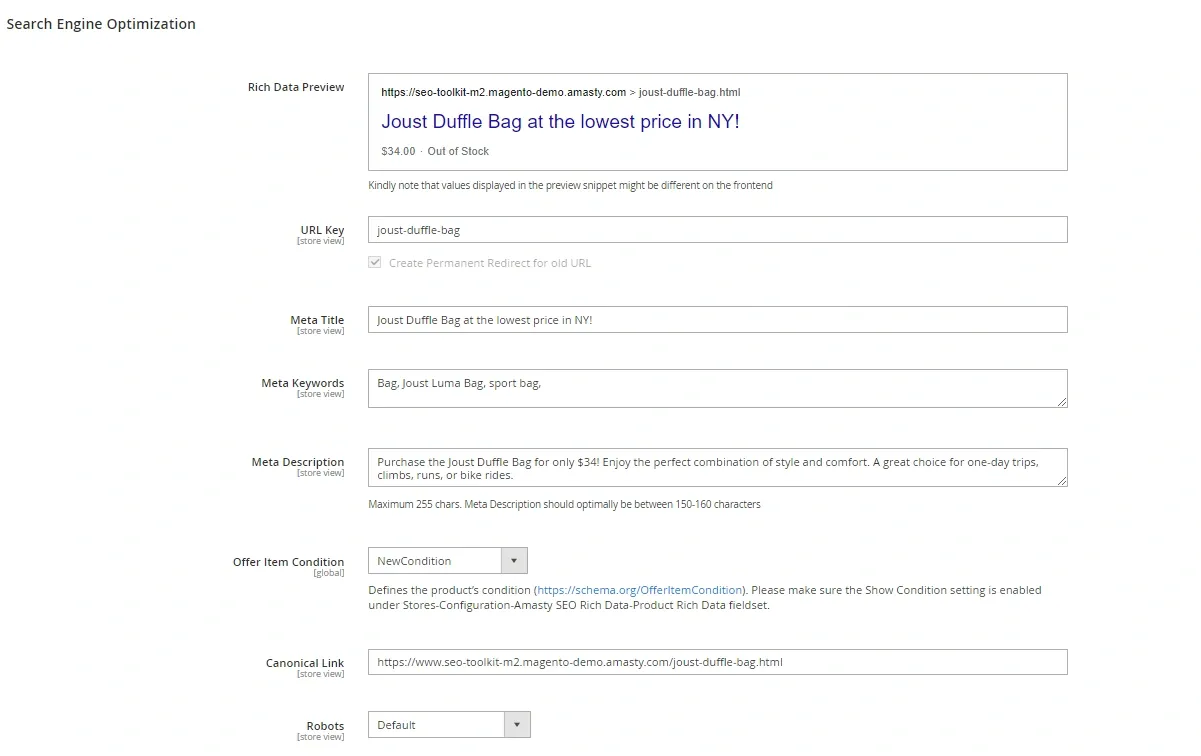
On the marketing side, Magento's built-in tools let you create highly effective campaigns and product deals that appeal to a broad range of audiences. Key features include:
- Coupons: You can create personalized discounts and exclusive promotions that cater to loyal customers or specific segments.
- Related products: With just a few clicks, Magento automatically recommends complementary products to customers to boost your cross-selling and upselling chances.
- Wish lists: This feature lets your customers save their favorite products for later, keeping them engaged and encouraging repeat visits.
- Product reviews: Here's where you can give your customers a platform to share their positive experiences, which helps build social proof and influence new buyers to choose your store.
To top it off, Magento offers over 543 marketing extensions (a staggering ten times more than OpenCart) ranging from $0 to $1200 per year. You can easily scale your marketing efforts while analyzing key performances and metrics to further drive the store's growth.
The Verdict
Overall, ZenCart leans heavily toward the tech-savvy crowd. Magento, on the other hand, offers something for everyone – both seasoned coders and beginners relying on built-in tools and plugins. This versatility is exactly why Magento continues to win against ZenCart in this round.
Integration Capabilities: Magento is More Versatile
Beyond just the main features, you’re probably eager to know how effortlessly ZenCart vs Magento connects with other tools or systems. To answer that burning question, we’ve dug deep into their integration strengths in the comparison below!
ZenCart integration
Unlike many of its competitors, ZenCart doesn't come with a built-in API or an easy way to integrate directly with external platforms or tools. That means if you're looking to connect ZenCart with CRM systems, accounting software, or other tools, you'll need to get creative! Some common options you may consider:
- Install ZenCart plugins and modules (quick fix for common integrations)
- Develop custom API (requires coding skills and a bit of technical know-how)
- Use third-party services like API2Cart.
Magento integration
On the contrary, Magento truly sets itself apart in this criterion, thanks to its robust API support.
Whether SOAP (Simple Object Access Protocol) or REST (Representational State Transfer) protocols, you're not confined to the default options! Instead, you have the freedom to customize every aspect of your business and conveniently integrate third-party tools like CRMs and ERPs. Simply put, such an impressive level of flexibility allows you to build a store that's not only high-performing but also fully tailored to your current needs.
The Verdict
While ZenCart can still manage integrations with the help of third-party tools, it lacks the seamless API support that Magento offers right out of the box. Therefore, Magento clearly takes the lead here.
Security: Magento Releases More Frequent Updates
With eCommerce merchants constantly under threat from hacking and data breaches, security has become more critical than ever. That’s why we’ve made it a priority in our ZenCart vs Magento showdown. Here’s what we have uncovered:
ZenCart security
All in all, the platform complies strictly with the PCI (Payment Card Information) standards to ensure cardholder information is always handled with care. Even better, while many platforms just focus on patching the core system, ZenCart takes one step further by offering security fixes and patches for plugins as well.
However, here's the flip side: ZenCart's patch releases are quite few and far between. Sure, the latest patch dropped in November 2024, but before that, users had been waiting since 2020. That's a staggering four-year stretch with no major updates!
Magento security
Like ZenCart, Magento also complies with PCI standards to safeguard sensitive payment information and give merchants peace of mind.
Furthermore, the platform is always on the lookout for new updates, with security patches rolling out every 2 to 6 months (far more frequently than ZenCart). As a result, you can reinforce the store's defense and address vulnerabilities before any harm can be done.
Recently, Magento 2.4.8 was announced with a focus on advanced security features such as enhanced Two-Factor Authentication (2FA) and improved CAPTCHA to protect against automated attacks. Other key features include:
- Optimized query processing for faster load times.
- Asynchronous API enhancements to handle large data loads efficiently.
- Advanced marketing tools for personalized promotions and SEO improvements.
For more details on security updates, you can turn to the Magento Security Center. It provides a steady stream of critical reports to keep you informed: new security patches, current issues (if any) and their severity, which versions are at risk, and more.
The Verdict
Both ZenCart vs Magento adhere to PCI standards, so you can trust that you and your customers' data are secure. However, when it comes to ongoing protection, Magento is the clear winner with its far more frequent security updates.
Customer Support: Magento Has More Resources
Last but not least, strong customer support is very essential for open-source platforms like ZenCart vs Magento. Otherwise, users will easily get lost in the countless customization possibilities! In this section, let's see whether each platform truly delivers the required level of guidance and support we expected:
ZenCart customer support
If you’re hoping for basics like phone support (or even live chat), you’re out of luck! Your only lifeline is the official documents and the community forum where users help each other out – far from ideal if you need quick answers or expert assistance. So, there’s no way around it: ZenCart’s customer support is seriously lacking.
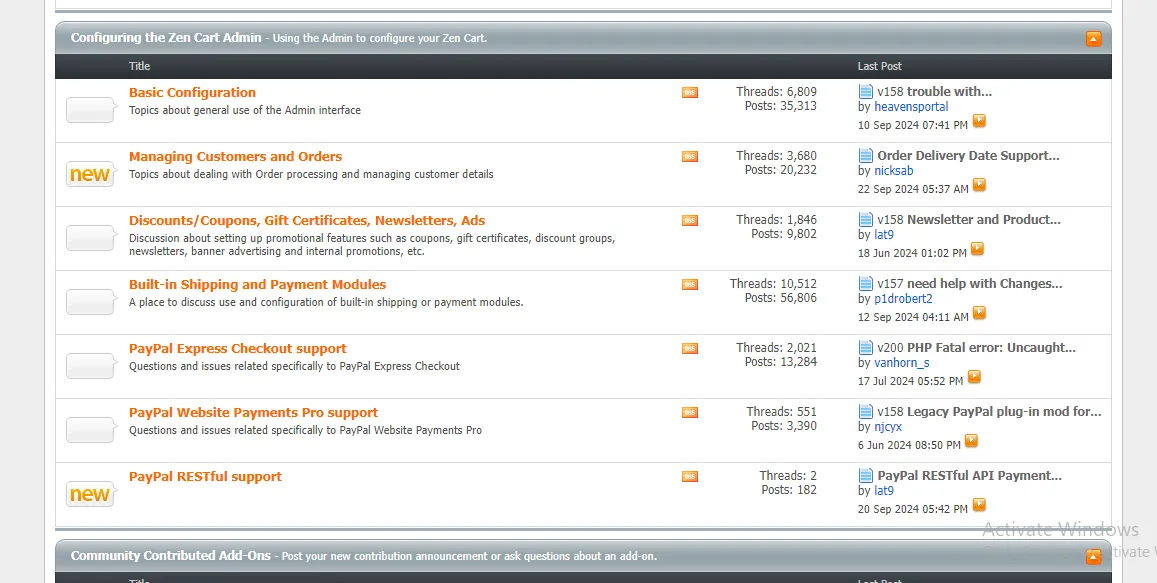
Magento customer support
Like ZenCart, Magento offers a robust and well-structured knowledge base packed with comprehensive guides to help you through every stage of managing your store. Its community forum is also lively and responsive!
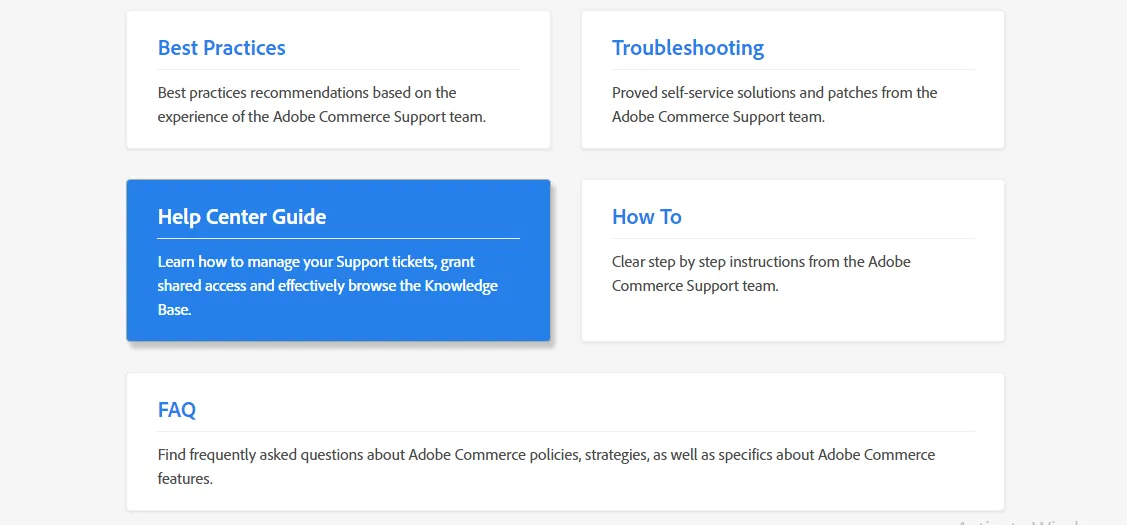
Still, where Magento truly shines is its direct support options. You can get real, personalized human assistance by dialing 1-800-685-3624 or sending your email to [email protected].
The Verdict
Magento not only provides a wealth of self-help resources but also gives users access to direct, personalized support. This human touch is what ZenCart still falls short on, making Magento the winner once again.
Which Should I Pick, ZenCart vs Magento?
Even though Magento claims the crown in the battle, ZenCart holds its own and can still be an excellent option for many business owners!
- ZenCart's pricing is significantly lower than Magento (only from $824 to $3,920 per year). Hence, it's a great choice for small businesses and start-ups with limited budgets. Plus, since businesses of these sizes usually have simple needs, the official documentation and active community forums can help them resolve most common issues.
- On the other hand, Magento's higher expenses totally justify the investment with its superior performance and eCommerce features. As a result, it will be ideal for medium to large businesses with more complex needs. And if any challenges arise, you can always count on Magento's dedicated support team to provide expert guidance and solutions.
ZenCart vs Magento: FAQs
Is Zen Cart a good eCommerce platform for beginners?
Zen Cart is a decent option for beginners who want a free and customizable eCommerce solution. However, it requires manual setup and technical knowledge for customization, making it less beginner-friendly compared to modern, user-friendly platforms like Shopify or WooCommerce.
Is Magento the best eCommerce platform?
Magento comes with plenty of benefits, but deciding if it's the perfect platform for your business depends on your unique needs. If you're still weighing your options, check out our in-depth Magento vs. Shopify, Magento vs. WooCommerce, or Magento vs. Prestashop comparisons to get a clearer picture.
What are the main differences between Magento and Zen Cart?
Magento offers robust flexibility and advanced features, making it ideal for businesses with complex requirements. Meanwhile, Zen Cart is more user-friendly and a better fit for small to medium-sized businesses.
Why do businesses choose Magento over Zen Cart?
Businesses prefer Magento because of its scalability, robust feature set, and superior customization options. While Zen Cart is suitable for small stores with basic needs, Magento provides better performance, SEO tools, and third-party integrations, making it a better long-term investment.
What are the main drawbacks of using Zen Cart?
Zen Cart lacks modern features, has a steep learning curve, and offers limited support compared to competitors. While it’s highly customizable, many businesses find its interface outdated and its development community less active than Magento’s.
Is Magento a good choice for small businesses?
Magento is best suited for medium to large businesses with technical resources or development support. Small businesses with limited budgets and technical expertise may find Zen Cart, WooCommerce, or Shopify to be more practical options.
Final Words
Our ZenCart vs Magento comparison has given you a solid grasp of their strengths. While ZenCart is still a powerful competitor, Magento clearly outshines it in many key areas!
So, if you're ready to take your business to new heights, now's the time to make the switch with LitExtension's Magento migration service. With 12 years of expertise and 200,000+ successful migrations, we can ensure your transition is smooth, stress-free, and backed by our team every step of the way. Your business deserves all the best — why wait any longer to contact us?
For more information, check out our eCommerce guides and join our Facebook Community.

